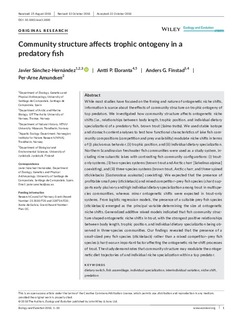| dc.contributor.author | Sanchez-Hernandez, Javier | |
| dc.contributor.author | Eloranta, Antti | |
| dc.contributor.author | Finstad, Anders Gravbrøt | |
| dc.contributor.author | Amundsen, Per-Arne | |
| dc.date.accessioned | 2017-11-13T08:36:13Z | |
| dc.date.available | 2017-11-13T08:36:13Z | |
| dc.date.created | 2017-01-03T14:53:32Z | |
| dc.date.issued | 2017 | |
| dc.identifier.citation | Ecology and Evolution. 2017, 7 (1), 358-367. | nb_NO |
| dc.identifier.issn | 2045-7758 | |
| dc.identifier.uri | http://hdl.handle.net/11250/2465685 | |
| dc.description.abstract | While most studies have focused on the timing and nature of ontogenetic niche shifts, information is scarce about the effects of community structure on trophic ontogeny of top predators. We investigated how community structure affects ontogenetic niche shifts (i.e., relationships between body length, trophic position, and individual dietary specialization) of a predatory fish, brown trout (Salmo trutta). We used stable isotope and stomach content analyses to test how functional characteristics of lake fish community compositions (competition and prey availability) modulate niche shifts in terms of (i) piscivorous behavior, (ii) trophic position, and (iii) individual dietary specialization. Northern Scandinavian freshwater fish communities were used as a study system, including nine subarctic lakes with contrasting fish community configurations: (i) trout-only systems, (ii) two-species systems (brown trout and Arctic charr [Salvelinus alpinus] coexisting), and (iii) three-species systems (brown trout, Arctic charr, and three-spined sticklebacks [Gasterosteus aculeatus] coexisting). We expected that the presence of profitable small prey (stickleback) and mixed competitor–prey fish species (charr) supports early piscivory and high individual dietary specialization among trout in multispecies communities, whereas minor ontogenetic shifts were expected in trout-only systems. From logistic regression models, the presence of a suitable prey fish species (stickleback) emerged as the principal variable determining the size at ontogenetic niche shifts. Generalized additive mixed models indicated that fish community structure shaped ontogenetic niche shifts in trout, with the strongest positive relationships between body length, trophic position, and individual dietary specialization being observed in three-species communities. Our findings revealed that the presence of a small-sized prey fish species (stickleback) rather than a mixed competitor–prey fish species (charr) was an important factor affecting the ontogenetic niche-shift processes of trout. The study demonstrates that community structure may modulate the ontogenetic diet trajectories of and individual niche specialization within a top predator. dietary switch, fish assemblage, individual specialization, interindividual variation, niche shift, predation | nb_NO |
| dc.language.iso | eng | nb_NO |
| dc.publisher | Wiley | nb_NO |
| dc.rights | Navngivelse 4.0 Internasjonal | * |
| dc.rights.uri | http://creativecommons.org/licenses/by/4.0/deed.no | * |
| dc.title | Community structure affects trophic ontogeny in a predatory fish | nb_NO |
| dc.type | Journal article | nb_NO |
| dc.type | Peer reviewed | nb_NO |
| dc.description.version | publishedVersion | nb_NO |
| dc.source.pagenumber | 358-367 | nb_NO |
| dc.source.volume | 7 | nb_NO |
| dc.source.journal | Ecology and Evolution | nb_NO |
| dc.source.issue | 1 | nb_NO |
| dc.identifier.doi | 10.1002/ece3.2600 | |
| dc.identifier.cristin | 1420123 | |
| dc.relation.project | Norges forskningsråd: 213610 | nb_NO |
| dc.relation.project | Norges forskningsråd: 228714 | nb_NO |
| dc.description.localcode | © 2016 The Authors. Ecology and Evolution published by John Wiley & Sons Ltd. This is an open access article under the terms of the Creative Commons Attribution License, which permits use, distribution and reproduction in any medium, provided the original work is properly cited. | nb_NO |
| cristin.unitcode | 194,31,10,0 | |
| cristin.unitname | Institutt for naturhistorie | |
| cristin.ispublished | true | |
| cristin.fulltext | original | |
| cristin.qualitycode | 1 | |

